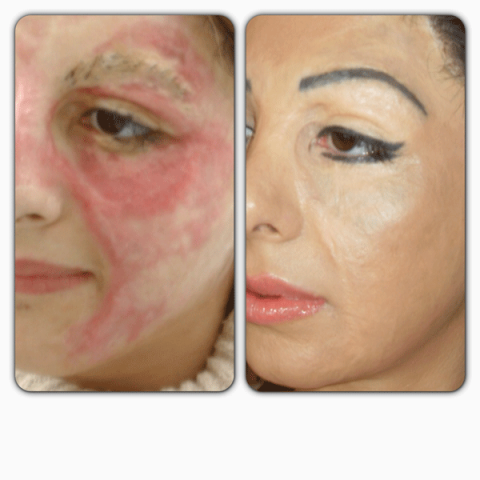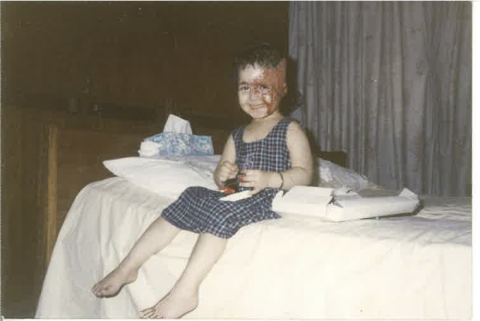
And she wants to have the procedure recognized as a legit medical expense that should be covered by government health plans.
Hameed is uniquely qualified both to offer the service to clients — which she insists transforms the lives of those living with birth marks, burns, cancer and surgery scars and other irregularities — and to advocate for its recognition as a form of necessary healing.
The Toronto-based esthetician and cosmetic tattoo artist — or a “para-medical micropigment specialist” — was seriously burned by hot oil in a cooking fire at age 2. At age 16, with roughly 40 percent of her face still covered in angry red scars despite multiple surgeries and a missing left eyebrow that three hair transplants had failed to fix, Hameed decided to experiment with cosmetic tattooing, first to restore the eyebrow, later to lighten the scars.
“I knew I had to search for something else,” Hameed tells Samaritanmag, “because the plastic surgeon just wasn’t able to give me a happy result. So I started investigating permanent makeup and talking with artists about pigment. This was 13 years ago, and it was really considered risky. But I was willing to go for it. I had nothing to lose.”
The results were so dramatic that Hameed went whole hog in tattooing the scarred portion of her face to make her skin tone look more like it had before the burn. She also decided to pursue the procedure as a career, studying esthetics at Toronto’s George Brown College and taking tattooing courses, using her own face as a canvas.
“Actually, apprenticeship is a better word because there were no courses for this kind of work,” she says. “But I did that for three years with a focus on cosmetic tattooing as opposed to the usual body adornments you see.”
Today, the three-year-old Basma Hameed Clinic offers three branches of service: the straight-up cosmetic side providing permanent makeup like eyebrows and eyeliner; the para-medical side which works to restore ravaged skin tones; and a just-launched training academy for students of both procedures. Hameed, who insists technique is everything, personally oversees the training.
All this, and the 29-year-old operates the Basma Hameed Survivors Foundation. “The objective,” she writes on her website, “is to educate fellow survivors and the greater public by advocating the available methods for burn and scar survivors through para-medical scar camouflaging, laser treatment and hair transplants to help survivors to regain their lives.”
Hameed’s Foundation also helps those who require her services but can’t afford it.
STORY CONTINUES AFTER THE VIDEO:
“I started the Foundation about two years ago,” says Hameed, who splits her time between Toronto and Chicago, where she also operates a clinic. “Typically, people need between eight to 20 treatments. So I would select really severe cases and work with them the entire time until they were satisfied.
“I could relate to them because I had been in the same position. I knew firsthand what it was like to go from doctor to doctor for treatments that end up costing thousands of dollars.
“In terms of fundraising, my clients have been very supportive. They know my story and my work and they help out. It’s hard to know how many people I have helped but it’s a lot. Maybe 80 cases in the last two years and it’s ongoing. Right now I have 92 people on the waiting list.”
Though the para-medical side of her business is closest to her heart, Hameed says that her client base is about 50-50 in terms of those who come in for cosmetic work and those seeking camouflage. But the two client streams frequently overlap.
“Often what happens is someone comes in for, let’s say eyebrows, and then we start discussing other procedures. Clients will say, ‘I have this birthmark but I didn’t know you could do anything about it.’ Similarly, you’ll have someone come in for work on a scar and they decide to go ahead with permanent eyeliner.
“Permanent makeup is not a new procedure but that same technique can camouflage all kinds of scars and that’s a fairly new concept,” Hameed says.

“I had to accept my accident; that was the number one thing. But you go through that and then you can move forward. And I am still not perfect, but my face is better and [the procedure] gave me much more confidence.”
Hameed says that “the medical has community reached out to me because they feel my work is a great add-on to their practice,” confirming that certain reconstructive and cosmetic procedures are covered by Ontario Health Insurance (OHIP). But her para-medical tattooing is not. “At this point it is considered cosmetic,” she says.
“It’s funny. If you have a burn on your face, OHIP will cover a laser treatment. But if you have a burn on your chest or neck or basically anywhere else, OHIP will not cover it. I have contacted them and they’re not interested in exploring this.
“But the more stories I can get out about this, the better. Laws have to change. Eventually someone in a position to do something about this will hear about it and make that call.”
Asked if she knows how widespread the practice of scar and burn camouflage is, Hameed says, “In the last couple of years, more people are doing this. Stories like mine are prompting technicians, tattoo artists to get into para-medical work.
“The stories you hear inside this clinic… people come in and we cry all the time because people are so hurt. I had one client with a birthmark on her face, and when she was 10 years old, she was tied down by other kids during recess who tried to erase her birthmark with a pencil. They ended up scarring her even more.
“When you help people like that, they become new people. They go from not being able to look you in the eye to being confident. It’s very rewarding and that’s what keeps me motivated. That’s why I keep going.”
adidas garwen spezial white shoes